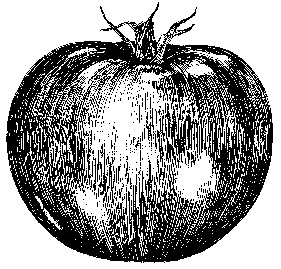
by Terry Kramer

The history, myths and legends surrounding the tomato make it a fascinating vegetable. What other vegetable has been the star of a terrible movie (Attack of the Killer Tomatoes), or the subject of a Supreme Court ruling? Consider this: 40 million gardeners grow tomatoes each year. There are more than 400 varieties of tomatoes, a testament to their popularity. Americans consume approximately 12 million tons of tomatoes annually, which translates to the average person eating 18 pounds of fresh and 70 pounds of processed tomatoes each year.
Knowing these facts it is difficult to believe that less than 200 years ago the tomato was reviled by northern Europeans and American colonists because they thought the fruit was poisonous. That is because the tomato is related to nightshade, a wild plant with toxic berries.
The tomato migrated to Europe from South America where it was cultivated by Aztecs and Incas in A.D. 700. Conquistadors brought seeds to Europe in the 16th century where the fruit was quickly embraced by Spain, Portugal and Italy.
As the tomato travelled north it became shrouded in clouds of mystery and superstition. The Latin name, Lycopersicon lycopersicum esculentum translates to edible wolf peach. For years it held the ominous moniker, devil's wolf apple, in Northern Europe. Italians called it the golden apple and the Spanish crowned it the Moor's apple. 
Somehow during the early 1800s the tomato took an amorous turn. The French called it the apple of love and the Germans the apple of paradise, clinging to the belief that eating tomatoes would create sexual stimulation. The tomato became known as the love plant.
The British were not convinced, however. They judged the glossy, succulent, red fruit to be poisonous, a belief they imbued in the minds of American colonists. However, the unconvinced Thomas Jefferson cultivated, ate and vigorously promoted the love apple.
The Creoles of New Orleans can take some credit for the popularity of the tomato. In the early 1800s they began cooking tomatoes to enrich their gumbos and jambalayas. Since the Creoles became neither sex-crazed, nor dead from eating tomatoes, the rest of the country followed suit and by 1850 the love apple became a popular fruit on American tables.
By the end of the 19th century the tomato became the subject of Supreme Court debate. Botanically the tomato is a fruit because the definition of a fruit is the edible part of the plant that contains seeds, while a vegetable is the edible stems, leaves and roots of a plant. But the Supreme Court ruled in 1893 that the tomato is a vegetable, so we call it such.
While in the old days tomatoes were thought to be either poisonous or sexually stimulating, today they are deemed a most nutritious vegetable. One medium tomato contains 35 percent of the RDA of vitamin C and 15 percent of the RDA of vitamin A. They are cholesterol-free, sodium-free and rich in fiber.
Tomatoes are also the subject of scientific research. Researchers at Cornell University have identified two substances in tomatoes that fight cancer: P-courmaric and cholorogenic acids inhibit the production of cancer-causing elements. Tomatoes are also high in lycopenes, another cancer-fighting compound.
In spite of today's knowledge of the tomato, it still has stirred controversy. Remember back in 1994, the skirmish that erupted when the FDA approved Calgene's genetically modified tomato, the Flavr Savr? Genetic engineering led to the breeding of a tomato that could ripen on the vine, yet remain firm enough to survive shipping without crushing or bruising. Consumer groups boycotted the Flavr Savr tomato, calling it the "tomato of death." I ate one.
Comments? E-mail the Journal: [email protected]